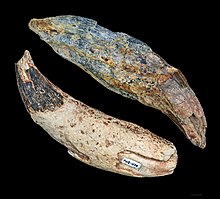Entelodon
| Entelodon Temporal range: Houldjinian–Rupelian
| |
|---|---|

| |
| Two mandibular canines of E. magnus at the MHNT | |
| Scientific classification | |
| Domain: | Eukaryota |
| Kingdom: | Animalia |
| Phylum: | Chordata |
| Class: | Mammalia |
| Order: | Artiodactyla |
| Family: | †Entelodontidae |
| Genus: | †Entelodon Aymard, 1846 |
| Type species | |
| †Entelodon magnus Aymard, 1846
| |
| Species | |
| |
| Synonyms | |
| |
Entelodon (meaning 'complete teeth', from Ancient Greek ἐντελής entelēs 'complete' and ὀδών odōn 'tooth', referring to its "complete" eutherian dentition[1]), formerly called Elotherium, is an extinct genus of entelodont artiodactyl endemic to Eurasia. Fossils of species are found in Paleogene strata ranging in age from the Houldjinian (37.2–33.9 mya) until the Rupelian epoch of the early Oligocene (33.9–28.4 mya).[2]
Taxonomy
[edit]It is one of four entelodont genera native to Eurasia, the other three being the primitive Eoentelodon of late Eocene China, Proentelodon of middle Eocene Mongolia and the gigantic Paraentelodon of mid-to-late Oligocene Central Asia.
Description
[edit]
Entelodon was a fairly typical entelodont, with a large, bulky body, slender legs, and a long snout.[3][1][4][5]
Like other entelodonts, Entelodon had complete eutherian dentition (3 incisors, 1 canine, 3 premolars, and 3 molars per quadrant). It had only two toes on each foot, and its legs were built for fast running.[6] Its long, wide head was supported by a robust, short neck,[6] and its cheekbones were greatly enlarged and protruded noticeably from the sides of the head.[7] Though it was more closely related to hippos and whales than pigs, its skull was generally pig-like.[6][7] It is presumed to have been an omnivore.
European species of Entelodon were around 1.35 metres (4 ft 5 in) tall at the shoulders, with a 65 centimetres (26 in) skull.[6] Entelodon major, known from the Kutanbulak Formation in Kazakhstan was around 1.70 metres (5 ft 7 in) tall at the shoulders, with a 80 centimetres (31 in) skull, making it one of the largest entelodonts.
Paleoecology
[edit]
Entelodon remains are primarily known from Europe,[8][9][10] although fossils have also been found in Kazakhstan, Mongolia, China, and even as far east as Japan.
Entelodon magnus populated a broad swath of Europe, with remains found in Spain, Germany, France, Romania, and the Caucasus. Extensive remains of Entelodon deguilhemi were uncovered in Vayres-sur-Essonne, France.[6][11] The Chinese Entelodon dirus is known from a single tooth discovered in Nei Mongol.[12]
See also
[edit]References
[edit]- ^ a b Foss, Scott E. (2007). "Family Entelodontidae". In Prothero, Donald R.; Foss, Scott E. (eds.). The Evolution of Artiodactyls. Baltimore: Johns Hopkins University Press. pp. 120–129. ISBN 9780801887352.
- ^ PaleoBiology Database: Entelodon, basic info
- ^ Foss, Scott E. (2001). Systematics and Paleobiology of the Entelodontidae (Mammalia, Artiodactyla). DeKalb, Illinois: Ph.D Dissertation. Department of Biological Sciences, Northern Illinois University. ProQuest 304715809.
- ^ Scott, W. B. (1898). "The Osteology of Elotherium". Transactions of the American Philosophical Society. 19 (3): 273–324. doi:10.2307/1005496. ISSN 0065-9746. JSTOR 1005496.
- ^ Marsh, O. C. (1894-05-01). "Restoration of Elotherium". American Journal of Science. s3-47 (281): 407–408. Bibcode:1894AmJS...47..407M. doi:10.2475/ajs.s3-47.281.407. ISSN 0002-9599. S2CID 130683520.
- ^ a b c d e Agustí, J and Antón, M (2002). Mammoths, Sabertooths, and Hominids: 65 Million Years of Mammalian Evolution in Europe. Retrieved from Google Books
- ^ a b Joeckel, R. M. (1990). "A Functional Interpretation of the Masticatory System and Paleoecology of Entelodonts". Paleobiology. 16 (4): 459–482. doi:10.1017/S0094837300010198. JSTOR 2400970.
- ^ Aymard, A. (1846). "Essai monographique sur un nouveau genre de mammifere' fossile trouve dans la Haute-Loire, et nomme Entelodon". Annales de la Société d'Agriculture, Sciences, Arts et Commerce du Puy. 12: 227–267.
- ^ Pomel, A. (1847). "Note sur un nouveau genre de pachydermes du bassin de la Gironde (Elotherium magnum)". Bulletin de la Société Géologique de France. 2 (4): 1083–1085.
- ^ Pomel, A. (1847). "Sur un nouveau genre de Pachydermes fossiles (Elotherium) voisin des Hippopotames". Archives des Sciences Physiques et Naturelles. 5: 307–308.
- ^ Paleobiology Database:Entelodon deguilhemi
- ^ Paleobiology Database:Entelodon dirus
